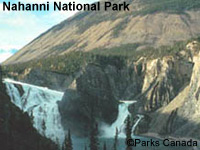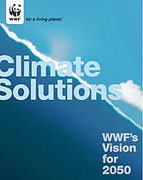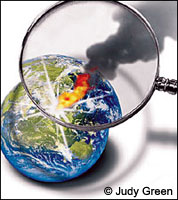
News |
- World's Mayors Lead Global Warming Action
- US Court Imposes Ban on GE Alfalfa
- Encyclopedia to Catalogue Life on Earth
- The Forks to Host Boreal Exhibit
- National Park Expansion at Risk
- Ethanol Fuels May Increase Health Risks
- 2007 Election Manitoba Environment Commitments
- 1,500 Scientists Call for Boreal Protection
- Next Five Years Key to Planet's Future
- CPP Demands More Transparency
- Canada's Conservation Movement Mourns
- IPCC Releases 3rd 2007 Climate Change Report
| World's Mayors Lead Global Warming Action | 13 June 07 |
 In a May 17th statement, city leaders from around the world declared they can no longer wait for national governments to reverse global warming and instead must find solutions on their own.
In a May 17th statement, city leaders from around the world declared they can no longer wait for national governments to reverse global warming and instead must find solutions on their own.Mayors from 34 of the world's largest cities met in New York City in May 14-17, 2007 to discuss dangers of catastrophic climate change and need for immediate action. The C40 Leadership Group is a group of the world's largest cities committed to addressing climate change. New York Mayor Michael Bloomberg and former President Bill Clinton hosted the summit. Cities are responsible for three-quarters of the world's energy consumption and therefore the world's largest cities have a critical role to play in reduction of carbon emissions and reversal of dangerous climate change. The May 17th Mayors communiquè calls on G8 leaders to take the latest assessments of the IPCC and the findings of the Stern review into account in their discussions. The Mayors note the urgency of beginning global negotiations on a post-2012 framework to address climate change under the UNFCCC. The Mayors stress the importance of ensuring there is no gap between the current commitment period under the Kyoto Protocol to 2012 and the framework that will address emissions reduction commitments after 2012. View the joint communiquè agreed to by all attending cities at Large Cities Climate Summit 2007 (PDF) View May 17, 2007 press release from Mayor of London View May 16, 2007 article in Guardian Unlimited View May 19, 2007 Environmental News Service article on People and Planet Visit New York City Climate Summit website Visit Large Cities Climate Summit 2007 website Visit C40 Cities - Climate Leadership Group website Source: Mayor of London, Large Cities Climate Summit 2007, Environmental News Service, Associated Press
|
|
| US Court Imposes Ban on GE Alfalfa | 06 June 07 |
 On May 3, 2007, a US federal judge handed down a ruling, making permanent the March injunction banning sale of Monsanto Co.'s genetically modified alfalfa and any planting of the seed after March 30th.
On May 3, 2007, a US federal judge handed down a ruling, making permanent the March injunction banning sale of Monsanto Co.'s genetically modified alfalfa and any planting of the seed after March 30th.The ruling follows the February decision by Judge Charles Breyer in the Federal Northern District of California that the U.S. Department of Agriculture's (USDA's) 2005 approval of Monsanto's genetically engineered (GE) "Roundup Ready" alfalfa was illegal. Judge Breyer found the USDA violated national environmental laws by approving GE alfalfa without a full Environmental Impact Statement and by failing to address concerns that Roundup Ready alfalfa will contaminate conventional and organic alfalfa. The GE alfalfa seeds are now in their second season of use. GE seeds are grown in 200,000 of the nation's 23 million acres of alfalfa. The Monsanto seeds were re-engineered so that alfalfa plants can resist ill effects of another Monsanto product, the herbicide known as Roundup. Some farmers say they can get greater crop yield and better quality alfalfa using the Monsanto seeds and herbicide combination. View the May 3, 2007 Center for Food Safety press release View the March 12, 2007 Center for Food Safety press release View the February 14, 2007 Center for Food Safety press release View the March 12, 2007 Reuters article View the March 13, 2007 New York Times article View the February 15, 2007 Reuters article on Environmental News Network Source: Center for Food Safety, Reuters, Los Angeles Times
|
|
| Encyclopedia to Catalogue Life on Earth | 06 June 07 |

"The Encyclopedia of Life plans to create an entry for every named species," James Edwards, executive director of the project. The free Encyclopedia will focus mainly on animals, plants and fungi with microbes to follow, blending text, photographs, maps and videos in a common format. Expansion of the Internet in recent years has made the multi-media project possible. For the each species' portal page the Biodiversity Heritage Library (BHL), a consortium that holds relevant scientific literature, will scan and digitize tens of millions of pages for open access to detailed knowledge. The BHL has scanning centers operating in London, Boston, and Washington DC "I dream that in a few years wherever a reference to a species occurs on the Internet, there will be a hyperlink to its page in the Encyclopedia of Life," concluded Edwards. View the May 9, 2007 Encyclopedia of Life press release View the May 10, 2007 Reuters article on Planet Ark View the May 9, 2007 Voice of America article Visit the EOL demonstration pages Source: Encyclopedia of Life, Reuters
|
|
| The Forks to Host Boreal Exhibit | 04 June 07 |
 A pilot and team of photographers from across Canada are preparing to embark on their expedition across Canada to capture the essence of the Boreal Forest. They depart Winnipeg June first; the project culminates in August with a series of outdoor exhibitions across Canada. The outdoor installation of boreal photography is scheduled to open in downtown Winnipeg at The Forks August 14, 2007.
A pilot and team of photographers from across Canada are preparing to embark on their expedition across Canada to capture the essence of the Boreal Forest. They depart Winnipeg June first; the project culminates in August with a series of outdoor exhibitions across Canada. The outdoor installation of boreal photography is scheduled to open in downtown Winnipeg at The Forks August 14, 2007.The project is called 'RESPECT' - "because of the attitude we must adopt to preserve our natural resources. We hope that the images and the stories we back will help promote the boreal forest," says Louise Larivière, Chief of Mission for the project. "RESPECT is an adventure we want to share with Canadians, especially people living in the city. When I started this project I felt, well, if those urbanites don't go to the forest, the forest will come to them." Canadian First Nations play an important role in the project. The team visited Poplar River First Nation during their winter assignment and the community will be first stop of the June 2007 expedition. The team will continue in Manitoba, and the move to Saskatchewan, Lac LaRonge, Athabasca region and west to Northern BC, Yukon and North Territories. Photographers donate their time, and all expedition costs are donated. Reporters Communication is a non-profit organization dedicated to communication through photography. RESPECT, the outdoor show, will open at The Forks August 14, 2007. View more information about the FORESPECT project Visit the FORESPECT website Visit the Reporters Communication website Source: Reporters Communication
|
|
| National Park Expansion at Risk | 04 June 07 |
 Conservationists are sounding the alarm in the wake of a decision by the Mackenzie Valley Land and Water Board to permit reconstruction of a 170 km winter road through the heart of the Northwest Territories Nahanni wilderness area.
Conservationists are sounding the alarm in the wake of a decision by the Mackenzie Valley Land and Water Board to permit reconstruction of a 170 km winter road through the heart of the Northwest Territories Nahanni wilderness area. The Board issued a land use permit for five years to Canadian Zinc Corporation, which owns the proposed Prairie Creek mine. Under the permit, the company would use the road to haul supplies such as diesel fuel into the mine, and toxic chemicals such as cyanide out. The re-constructed winter road would run directly through the mountainous Nahanni karstlands - an area identified for protection through expansion of Nahanni National Park Reserve. The Nahanni is also a renowned World Heritage Site and premier canoeing destination. The national park expansion includes the South Nahanni watershed and could increase the park area to 38,000 square kilometres. "If the road [and Prairie Creek mine] go through . . . threats to the ecological integrity of the Nahanni would be significant. This area is simply too fragile for industrial activity, due to its karst topography and being prone to earthquakes, " says Alison Woodley, Canadian Parks and Wilderness Society's (CPAWS) Northern Conservation Specialist. CPAWS wants Canada's federal government to step in and ensure no industrial development proceeds in lands for expansion of the park. Current and previous federal Environment Ministers have supported the Nahanni expansion. Canadian Zinc president John Kearney said he expects existing mineral leases to be honoured and that his company will co-operate with any expansion plans. View the May 3, 2007 CPAWS press release View the May 6, 2007 Canadian Press article on CBC News Source: CPAWS, Canadian Press
|
|
| Ethanol Fuels May Increase Health Risks | 04 June 07 |
 Ethanol vehicles may have worse effects on human health than gasoline, US scientists have warned.
Ethanol vehicles may have worse effects on human health than gasoline, US scientists have warned.It has been promoted as a greenhouse gas-cutting fuel, but a new study indicates ethanol would have serious health effects if heavily used in cars, producing more ground-level ozone than conventional gasoline. Ozone is a key ingredient in smog, and when inhaled even at low levels it can harm lungs, aggravate asthma and impair immune systems. A Stanford University study released April 18, 2007 authored by Mark Z. Jacobson, says E85 - 85% ethanol and 15% gasoline - vehicles reduce atmospheric levels of two carcinogens, benzene and butadiene, but increase two other carcinogens, formaldehyde and acetaldehyde. According to Jacobson, who is associate professor of civil and environmental engineering, cancer rates for E85 are likely to be similar to those for gasoline. Further, health effects from ethanol are the same whether it is made from corn or other plant products. "Today, there is a lot of investment in ethanol," Jacobson said. "The question is, if we're not getting any health benefits, why continue to promote ethanol?" Jacobson says, "Converting all vehicles to battery-electric, where the electricity is from wind energy would eliminate 10,000 air pollution deaths per year and 98% of carbon emissions from vehicles." View the May 6, 2007 Sacramento Bee article View the April 18, 2007 Los Angeles Times article View the April 18, 2007 BBC News article View the April 18, 2007 Science Daily article View the April 18, 2007 journal article in Environmental Science and Technology Source: Los Angeles Times, BBC News
|
|
| 2007 Election Manitoba Environment Commitments | 01 June 07 |
|
Source: Manitoba Wildlands, Manitoba NDP, Manitoba Progressive Conservatives, Manitoba Liberal Party, Manitoba Green Party
|
|
| 1,500 Scientists Call for Boreal Protection | 28 May 07 |
 1,500 highly respected scientists from more than 50 countries are urging federal, provincial, territorial and Aboriginal governments, companies, communities and others to protect Canada's boreal forest. 1,500 highly respected scientists from more than 50 countries are urging federal, provincial, territorial and Aboriginal governments, companies, communities and others to protect Canada's boreal forest. The scientists identify most of the 1.4 billion acre Canadian boreal forest as one of the largest intact forest and wetland ecosystems remaining on earth. Canada's boreal forest is also part of the single largest terrestrial carbon storehouse in the world, making its protection a critical element in mitigating climate change. It also supports 3 billion migratory songbirds, the world's largest caribou herds and large populations of bears, wolves, lynx and fish. The scientists are calling for at least half of Canada's boreal forest to be protected from development and the other half to be carefully managed, in accordance with the Boreal Conservation Framework. Manitoba's governing New Democratic Party endorsed the scientists' call for boreal protection and pledged to protect Manitoba's east side boreal region during the recent election campaign. f View the May 14, 2007 Canadian Boreal Initiative / Boreal Songbird Initiative press release (DOC) View the May 17, 2007 Manitoba NDP press release (DOC) View May 14, 2007 CBC article View May 15, 2007 Reuters article View May 14, 2007 Scientists' letter & listing (PDF) Sources: Canadian Boreal Initiative, Boreal Songbird Initiative, CBC, Reuters
|
|
| Next Five Years Key to Planet's Future | 28 May 07 |
 The world has more than enough sustainable energy and technology to curb climate change, if key decisions are made within the next five years, according to new research by WWF International.
The world has more than enough sustainable energy and technology to curb climate change, if key decisions are made within the next five years, according to new research by WWF International.More than 100 scientists and experts contributed their knowledge to Climate Solutions: WWF's Vision for 2050 from WWF's Energy Task Force." The task force reviewed 25 different commercially available sustainable energy sources or technologies and ranked them. Those technologies found to have more benefits than negative impacts were run through the newly designed WWF Climate Solutions model. The findings were clear. The model shows, with greater than 90% probability, that known energy sources and proven technologies could be harnessed to meet a projected doubling in global demand for energy while at the same time achieving necessary significant drop (about 60-80%) in carbon dioxide emissions to prevent dangerous climate change. The model shows for the first time this is technically and industrially feasible. It also shows that measures must be taken within five years to bring about reduction in emissions within the next ten years. View the May 15, 2007 WWF International press release View the May 2007 WWF Global Energy Task Force report, Climate Solutions - WWF's Vision for 2050 (PDF) View the May 15, 2007 press release on Earthtimes.org Source: WWF International
|
|
| CPP Demands More Transparency | 28 May 07 |
 The Canada Pension Plan (CPP) Investment Board is demanding transparency from companies it invests in when it comes to environmental, social and governance factors. The Canada Pension Plan (CPP) Investment Board is demanding transparency from companies it invests in when it comes to environmental, social and governance factors.At the Conference Board of Canada's National Corporate Social Responsibility (CSR) Conference, the CPP Investment Board announced it will become a signatory of the Extractive Industries Transparency Initiative (EITI). The EITI is a coalition committed to enhancing governance and transparency in resource-rich countries to mitigate investment risk in oil, gas and mining industries, Donald Raymond, Senior Vice-President of Public Market Investments for the CPP Investment Board, said, "Through enhanced transparency, we believe companies that adopt the EITI principles can reduce political and reputational risk and improve prospects for delivering long-term value to their shareholders." The CPP Investment Board will ask companies to reveal how they intend to deal with their carbon impact and their plans for mitigating it. Companies in the extractive sector - oil, gas and mining firms - will need to be transparent in their dealings overseas. The Investment Board manages the funds not needed by the Canada Pension Plan to pay current retirement benefits and had $110.8-billion in assets at the end of 2006. View the March 26, 2007 Canada Pension Plan Investment Board press release View the March 27, 2006 Globe and Mail article on Workopolis View the March 26, 2007 address to Conference Board of Canada's National CSR Conference by CPP Senior Vice President, Don Raymond(PDF) Visit the Extractive Industries Transparency Initiative (EITI) website Sources: CPP Investment Board, Globe and Mail
|
|
| Canada's Conservation Movement Mourns | 25 May 07 |
 Few knew of his remarkable generosity, but with his shocking death, Canadian conservationists are speaking out in a tribute to the country's greatest wilderness conservation philanthropist, Mr. Glen Davis. Few knew of his remarkable generosity, but with his shocking death, Canadian conservationists are speaking out in a tribute to the country's greatest wilderness conservation philanthropist, Mr. Glen Davis.Glen Davis was not a typical multimillionaire; he rode the subway, spent months hiking and paddling through the wilderness, always taking his friends with him . He didn't want attention as a result of his generosity. Over three decades he donated many millions to protecting Canada's big places in nature, and also to hospitals and universities. Mr. Davis was shot to death May 18th in a Toronto underground parking garage near the WWF Canada offices. Elizabeth May, described Mr. Davis as "one of my best friends" and talked about his environmental philanthropy. Davis felt that by protecting the environment he was doing something tangible, May explained. "If you protected a piece of forest, if you could protect a species from going extinct, that was a real contribution. That's what he cared about." Stephen Hazell, executive director of the Sierra Club said "He was not a guy that sought the limelight at all. . . His approach to expressing his love of nature was to fund people who were working on the ground." Gaile Whelan Enns commented, "It was a privilege to have known Glen. All of us learned from him, while enjoying his amazing hospitality, and counsel. He cared about Manitoba's forest regions, especially about the future of the east side. He was a friend to the eagles, caribou, bears, elk, and moose of our boreal forests." Glen Davis is survived by his wife of many years, Mary Alice. View the WWF Canada tribute to Glen Davis View the Canadian Parks and Wilderness Society (CPAWS) tribute to Glen Davis View the Sierra Club of Canada 2005 annual report, Glen Davis content on page 4 (PDF) Photo: © Scott Brammer / Coast Mountain Photography
Sources: CPAWS, WWF, Sierra Club
|
|
| IPCC Releases 3rd 2007 Climate Change Report | 25 May 07 |
 The latest Intergovernmental Panel on Climate Change (IPCC) conveys a strong message to global governments and policy-makers: Delaying action on climate change is no longer an option and the longer we wait to act, the harder and more expensive the task will be in the future. The latest Intergovernmental Panel on Climate Change (IPCC) conveys a strong message to global governments and policy-makers: Delaying action on climate change is no longer an option and the longer we wait to act, the harder and more expensive the task will be in the future.The May 4, 2007, IPCC Working Group III Summary Report, Climate Change 2007: Mitigation of Climate Change, reviews the latest science on the costs and ways to curb greenhouse gas (GHG) emissions growth. It asserts that it is possible to halt global warming if the world's emissions start to decline before 2015. The report also warns that a 50%-85% reduction in GHG emissions from 2000 levels must take place by the middle of this century if the average global temperature rise is to be kept below 2C, and 'major' impacts avoided. Although the IPCC acknowledges that it will take some serious effort and cost to combat climate change, it emphasizes that it won't cost as much as many leaders have been claiming. To limit the rise in temperatures to within 2C would cost only 0.12% of annual GDP over the next few decades and some of the measures the scientists highlight as effective measures to combat climate change may result in economic benefits. View the May 2007 Working Group III Contribution to the IPCC Fourth Assessment Report, Climate Change 2007: Mitigation of Climate Change - Summary for Policymakers (PDF) View a webcast of the May 4, 2007 IPCC press conference: Real Player, or Windows Media Player View Manitoba Wildlands' IPCC Reports webpage View the May 5, 2007 New York Times article View the May 4, 2007 Reuters article on ScientificAmerican.com View the May 4, 2007 Guardian Unlimited article View the May 4, 2007 BBC News article View May 4, 2007 The Grist article Sources: The Grist, New York Times, Chicago Tribune, People and Planet, Associated Press, Guardian Unlimited, BBC News, Reuters
|
|


 RSS Feeds:
RSS Feeds: With the environment front and centre during the 2007 Manitoba Provincial election, all major political parties made important commitments concerning Manitoba's environment.
With the environment front and centre during the 2007 Manitoba Provincial election, all major political parties made important commitments concerning Manitoba's environment.